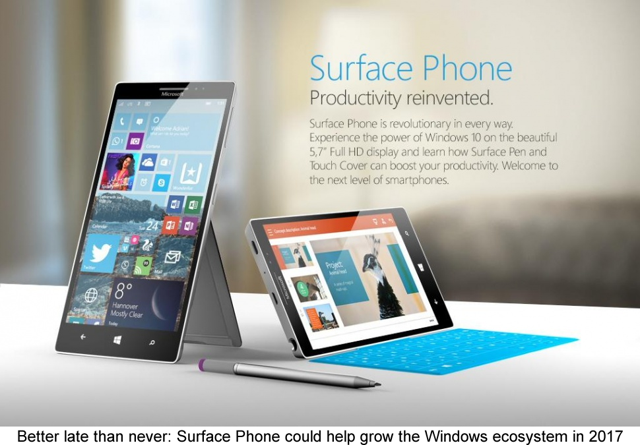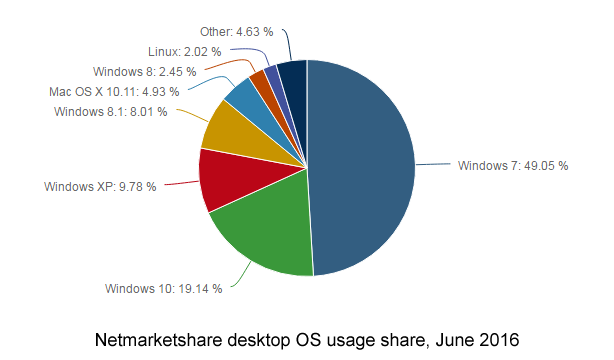Last Friday Microsoft (NASDAQ:MSFT) officially acknowledged that it wouldn't meet its goal of 1 billion Windows 10 users by 2018. This was commendable openness and very characteristic of CEO Satya Nadella's management style. Left open was the question of how or when Microsoft will reach its goal. Hopefully, investors will get insight into this in the upcoming earnings report on July 19.
 Click to enlarge
Click to enlarge
Source: PC Tablet
Uphill Battle
The news didn't come as a great surprise. Following Microsoft's March quarter earnings report I had expressed skepticism that Windows 10 could reach the 1 billion user goal before it was time for the next version of Windows. With a 2-3 year cycle for major Windows releases, time would run out by about 2018.
Although Microsoft has touted that adoption of Win10 has been the fastest in history, most of the current users have come from new PC sales. Since the release of Win10 in July 2015, there have been 265 million total sales of new PCs globally, according to IDC quarterly reports. Excluding Apple (NASDAQ:AAPL) Mac sales, about 245.9 million were Windows PCs. This means that only about 104 million out of the estimated 1.5 billion Windows users have taken advantage of the free Win10 upgrade.
It's been an uphill battle to win over existing Windows users to the new operating system. My simple thesis about this is that Windows 10 overall just isn't as good as Windows 7. This is despite offering new features such as the Windows Store and Cortana.
Certainly Windows 7 remains my personal favorite of all operating systems available in the world today, including the latest macOS. Although my personal take can only be viewed as anecdotal, it probably reflects the views of the larger body of Windows 7 users.
My basic problem with Win10 has been its split personality. The lack of visual and UI cohesion between desktop mode and tablet mode continues to be a source of annoyance and occasional consternation. I continue to believe that Microsoft's approach of convergence, offering a "single" OS for desktop, convertible, tablet and smartphone is the right answer. I continue to believe that it should be possible to offer a nearly seamless experience across all devices. It just hasn't been done yet, by anyone.
Given the limitations of Win10, there just hasn't been much motivation to upgrade for existing desktop users of Win7, and this is reflected in current usage as found by netmarketshare.com. As of June 2016, Windows 7 usage share was found to be 49%. This amounts to at least 735 million global users of Win7.

Just allowing more time for Win10 to gain converts isn't going to get to the goal. It remains to be seen what Microsoft will do in response. It could just declare "end of life" for Win7 in 2018 and kick everyone off the platform. This would probably result in a significant backlash from Win7 users, and I don't expect Microsoft to do this.
What Microsoft has to do is offer a new OS that's genuinely better than either Win7 or Win10. That's a tall order, but I'm convinced that it can be done, and probably will be in the next release. It would be helpful to investors if Microsoft offered some guidance as to it OS roadmap.
Windows Surface Phone: the Need is Now
Almost all reactions to the Microsoft acknowledgment have also pointed to the lack of mobile presence as part of the problem. This has been a central concern of mine for some time. The idea that Microsoft didn't need a smartphone was just silly considering how important the devices have become.
In my recent article on Surface Phone rumors I found encouragement in the concept of a Surface Phone. Surface Phone would be a premium, Microsoft designed, device along the lines of the Surface Pro. I love the concept and believe it could rejuvenate Microsoft's smartphone sales.
This is especially true because Continuum is a great feature that allows the smartphone to be converted easily into a desktop mode platform. Given the increasing power of smartphone processors, this is a usage model that I believe will be compelling for many consumers with modest computing needs. It's probably the lowest cost PC computing platform one could imagine, and therefore could be compelling in emerging markets where consumers can't afford multiple devices.
Given the complete collapse of the sales of the old Nokia-designed Lumia phones, Microsoft badly needs the Surface Phone to get back in the game. Unfortunately, most rumors about Surface Phone point to a 2017 1H release.
Why is it taking so long? There may be a silver lining in this. Microsoft may be waiting for the next generation of Intel (NASDAQ:INTC) mobile processors based on its next generation 10 nm process. Althought Intel has discontinued its current generation of mobile Atom processors for smartphones and tablets (the Atom X series), the 10 nm node may allow Intel to get back in mobile.
An Intel processor in the Surface Phone would be very welcome to Windows users, since it would greatly expand the software available for the Phone in desktop mode. This is all speculation right now, but I think it makes sense given where Microsoft needs to go. The Surface line has demonstrated that Microsoft can do mobile devices, and Microsoft desperately needs a smartphone.
Investor Takeaway
Every earnings season, focus tends to be on Cloud services, since this is a clear strength for Microsoft. Microsoft still has a very substantial Windows OS and device business (including Surface, OEM licensing, and Xbox) that still accounts for the lion's share of its revenue. Last quarter, More Personal Computing was about 43% of revenue, the largest of any segment.
Now that it's been acknowledged that Win10 isn't going to make the billion user goal, investors really need to hear what the game plan is to reach the goal. Hopefully, that plan involves a new Windows 11.
It'll be interesting to hear what, if anything, Microsoft has to say on this subject at the conference call tomorrow. I continue to regard Microsoft as a strong hold.
Disclosure: I am/we are long AAPL.
I wrote this article myself, and it expresses my own opinions. I am not receiving compensation for it (other than from Seeking Alpha). I have no business relationship with any company whose stock is mentioned in this article.
Source: Microsoft Will Need A Much Better Windows 11 To Reach The Billion User Goal
No comments:
Post a Comment